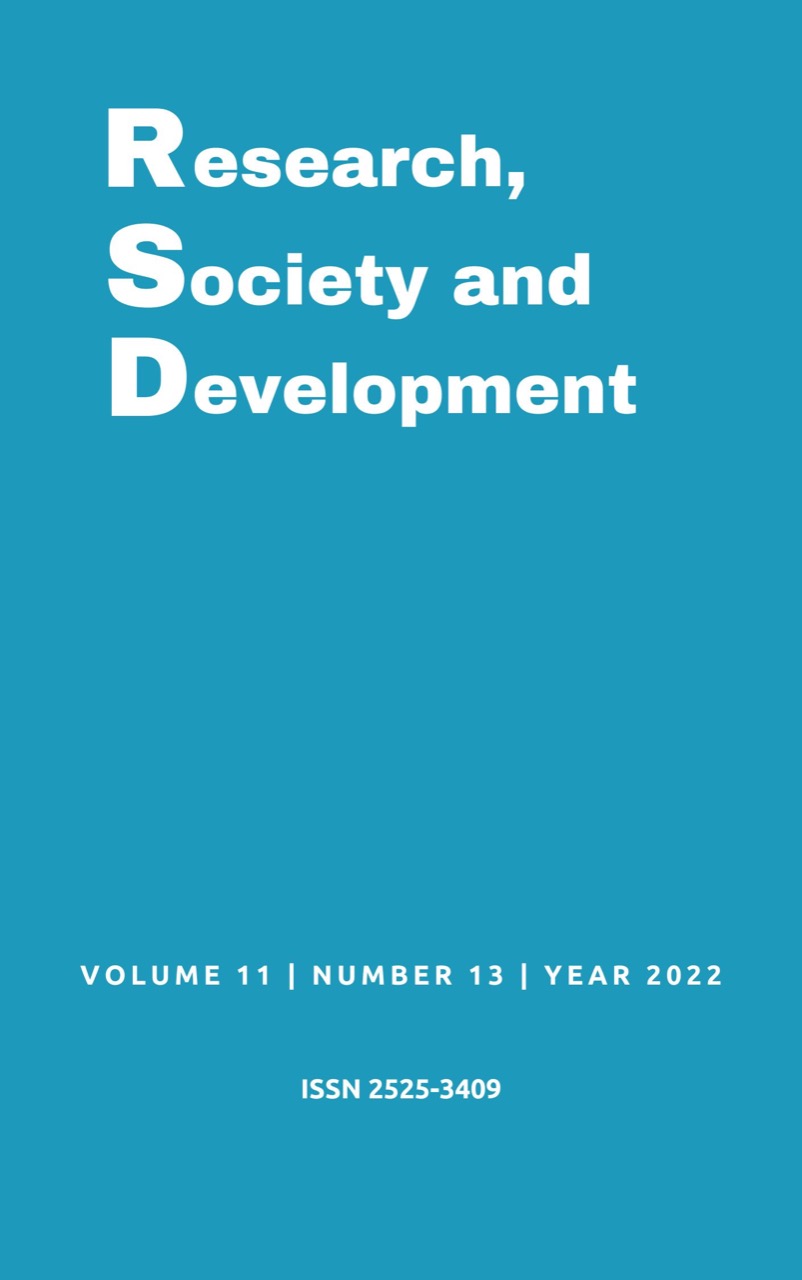Utilização de implantes zigomáticos para reabilitação oral: revisão de literatura
DOI:
https://doi.org/10.33448/rsd-v11i13.35259Palavras-chave:
Implantação dentária; Maxila edêntula; Zigoma; Cirurgia bucal.Resumo
A viabilização de reabilitação de maxilas atróficas provém de uma evolução ao transpassar dos anos, até adentrar na idealização e aplicação da instalação de implantes nos ossos zigomáticos. A literatura evidencia grande percentual de sucesso por meio da técnica e aceitação dentre os profissionais da área. Dessa forma, para total êxito do procedimento realizado, é necessário a associação de sapiência das estruturas anatômica, conhecimento prévio técnico e prático, além de cuidados pré-operatório, para o planejamento, assim como trans e pós operatório, para finalização da reabilitação. O objetivo do presente trabalho é esclarecer sobre manejos para reabilitação em maxilas atróficas com intuito de elevar a aplicação de técnicas como o uso de implantes zigomáticos em casos com inviabilidade da técnica convencional. Para desenvolver o presente trabalho, pesquisas feitas nas base de dados PubMed, Scientific Eletronic Library Online-SciELO e Google Acadêmico, sendo embasada com artigos nos idiomas Português, Inglês e Espanhol, visando fundamentar a presente revisão de literatura. Por meio do levantamento bibliográfico, os autores concluíram que o uso da técnica dos implantes instalados nos ossos zigomáticos para reabilitação de maxilas atróficas ou com inviabilidade do uso da técnica convencional configura um procedimento cirúrgico mais viável e com alto percentual de sucesso, quando comparado à reabilitação com implantes convencionais.
Referências
Almeida, S. R.; Araújo, D. B.; Campos, E. J. & Martins, G. B. (2019). Implantes zigomáticos de carga imediata: Relato de caso. Revista de Ciências Médicas e Biológicas, 8 (2), 275-281.
Aparicio, C. et al. (2014). Zygomatic implants: indications, techniques and outcomes, and the zygomatic success code. Periodontology, 66 (1), 41-58.
Balshi, T. J.; Wolfinger, G. J.; Shuscavange, N. J. & Balshi, S. F. (2012). Zygomatic bone-to-implant contact in 77 patients with partially or completely edentulous maxillas. Journal of Oral Maxillofacial Surgery, 70 (9), 2065-2069.
Barbosa, B., Bonetto, M. A., Chiamulera, L. & Barbieri, T. (2018). Implante zigomático – relato de caso. Ação Odonto, (2), 1.
Barreto, J. O. et al. (2019). Impactos psicossociais da estética dentária na qualidade de vida de pacientes submetidos a próteses: revisão de literatura. Archives of Health Investment, 8 (1), 48-52.
Brackamnn, M. S.; Vieira, R.; Júnior Ribeiro, P. D.; Sartori, I. A. M. & Padovan, L. E. M. (2017). Avaliação da satisfação de reabilitações com implantes zigomáticos. Revista Odontológica UNESP, 46 (6), 357-361.
Carvalho, L. F. et al. (2019). O impacto do edentuliso na qualidade de vida de pacientes edêntulos. Revista ACBO, 8 (1), 40-48.
Duarte, L. R. et al. (2010). Avaliação da qualidade de vida em pacientes edêntulos totais reabilitados com implantes zigomáticos. Revista ImplantNews, 7 (3a-PBA), 183-190.
Filho, H. N. et al. (2017). Zygomatic implant: late complications in a period of 12 years of experience. Revista Clínica de Periodoncia, Implantología y Rehabilitacion Oral, 10 (3).
Goiato, M. C. et al. (2013). Uso de implantes zigomáticos na fixação de próteses bucomaxilofaciais. Odonto, 21 (42), 65-70.
Júnior, A. J. A. P. & Pereira, I. P. F. (2016). Uso de ancoragem zigomática na reabilitação de maxila atrófica. Revista Fluminense de Odontologia, (54), 14-20.
Júnior, R. M. et al. (2018). Reabiliação oral de paciente com maxila atrófica por meio de implantes zigomáticos associados a implantes convencionais: relato de caso clínico. ClipeOdonto – UNITAU, 9 (1), 51-8.
Kawakami, P. Y. et al. (2011). Implantes zigomáticos: revisão de literatura com estudo do índice de sucesso através de meta-análise. Revista de Odontologia da Universidade de São Paulo, 23 (1), 51-58.
Malaquias, P. D. T. I. A. et al. (2013). Reabilitação de Maxila Atrófica com Implantes Zigomáticos: Relato de Caso. ArchHealth Invest, 2 (4), 29-34.
Moreira, J. R.; Peralta, F. S.; Guerreiro, T. C. & Scherma, A. P. (2016). Reabilitação de maxilas atróficas com implantes zigomáticos: relato de dois casos clínicos. ClipeOdonto, 8 (2), 36-44.
Peres, M. A. et al. (2013). Perdas dentárias no Brasil: análise da pesquisa nacional de saúde bucal. Revista Saúde Pública, 47 (3), 78-89.
Rocha, F. K. L. et al. (2020). Reabilitação de maxila atrófica com implantes zigomáticos: relato de caso. RFO UPF, 25 (1), 96-106.
Romeiro, R. L., Feitosa, P. C., Canôas, R. S. & Cunha, A. C. (2009). Implantes zigomáticos x reconstrução de maxila com enxerto ilíaco: relato de caso clínico. Periodontia, 19 (4), 82-88.
Venart M. S. & Malevez, C. (2010). Rehabilitation of totally atrophied maxilla by means of four zygomatic implants and fixed prosthesis: a 6–40-month follow-up. Journal of Oral and maxillofacial Surgery, 39 (4), 358–63.
Velez, A. M. et al. (2016). Implantes cigomáticos en pacientes com edentulismo maxilar y reabsorción óssea severa. CES Odontología, 29 (2), 40-51.
Downloads
Publicado
Como Citar
Edição
Seção
Licença
Copyright (c) 2022 Gabriela Dias Cardoso; Luis Gustavo Soares Lula de Oliveira; Luana Barbieri Trinta; Lara Carolyne de Sousa Flor; Bruno Nascimento Santos; Nicole Serra Diniz; Wendy Saureana Maior de Oliveira Nascimento; Mariana Helena Trinta Pereira; Claudio Vanucci Silva de Freitas; Ramon Barros Figueiredo

Este trabalho está licenciado sob uma licença Creative Commons Attribution 4.0 International License.
Autores que publicam nesta revista concordam com os seguintes termos:
1) Autores mantém os direitos autorais e concedem à revista o direito de primeira publicação, com o trabalho simultaneamente licenciado sob a Licença Creative Commons Attribution que permite o compartilhamento do trabalho com reconhecimento da autoria e publicação inicial nesta revista.
2) Autores têm autorização para assumir contratos adicionais separadamente, para distribuição não-exclusiva da versão do trabalho publicada nesta revista (ex.: publicar em repositório institucional ou como capítulo de livro), com reconhecimento de autoria e publicação inicial nesta revista.
3) Autores têm permissão e são estimulados a publicar e distribuir seu trabalho online (ex.: em repositórios institucionais ou na sua página pessoal) a qualquer ponto antes ou durante o processo editorial, já que isso pode gerar alterações produtivas, bem como aumentar o impacto e a citação do trabalho publicado.

